|

by Amarushka
Sedona's Dragon Kin
July 2012
from
Amarushka Website
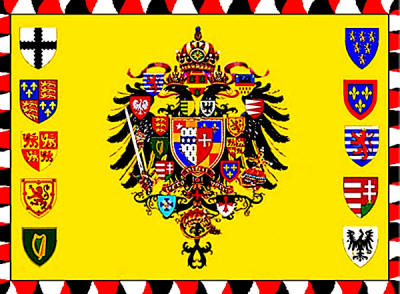
Crest of
Drakenberg Clans
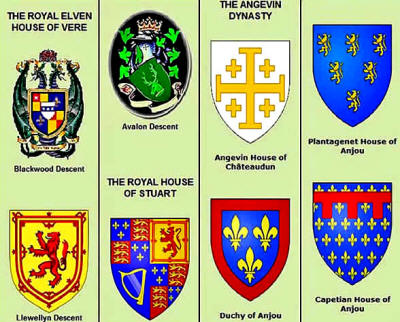
The Family
Bloodline House Crests of de Vere von Drakenberg
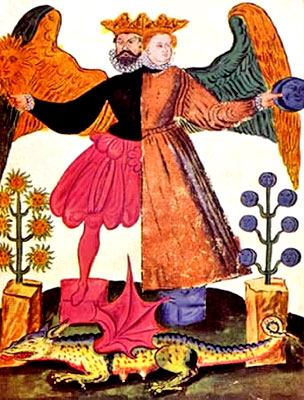
Alchemical
Blood Divinity
The Alchemical Dragon
Hermetic King and Queen Unified
I am the Hermetic King resurrected from
the sepulcher of the Nigredo.
My fire has been drawn out of the
darkness;
purified and exalted.
My expansive fire is Solar by nature and
I am called the Son of the Sun.
I am the purified and exalted
fire of your soul. I am the solar radiance of your consciousness
and the true Gold of the philosophers.
Blessed are they who
have assimilated the inner most nature of this most adorable Fire!
The Family Houses Of
Descent
-
The House of De Vere Von
Drakenberg, headed by H.R.H. Nicholas de Vere von Drakenberg,
a descendant of the Merovingian Royal Bloodline.
-
The House of Stuart (Stewart)
Currently overseen by H.R.H. Prince Michael of Albany
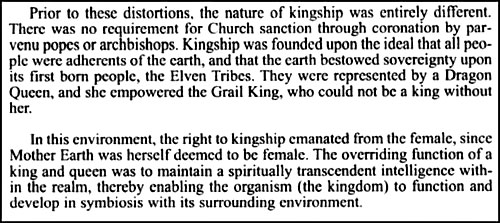
"The wisdom of the alchemists claims that all life is fire,
the soul of things. The light that emanates from it is our
mercury and this all rises from the salt of the earth.
No family is 'saltier,' -
physically, tangibly manifest - than that of the ancient and
royal Dragon bloodline. That is to say, their claims are far
older and more legitimate than many contenders would dare to
admit.
The self-rooted nobility of the
Dragon Family remains inextinguishable."
Prince Nicholas de Vere
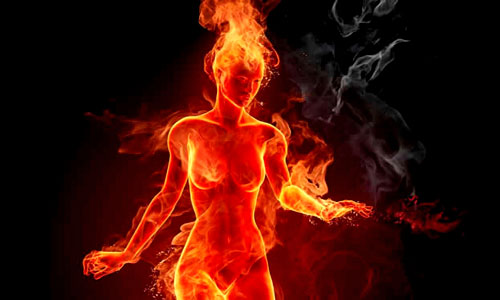
"Allow the Dragon fire of grace to rage within you and
engulf the vastness of your being.
Watch as it melts away every
fear and limitation you have ever imposed onto yourself - at
the rate at which every burning desire is met with heartfelt
sincerity without any need to satisfy or act upon its
endless list of demands.
This is the doorway into true
liberation. It is where innocence and excitement recognizes
itself, as the endless depths of intimacy, freely dwelling
in the hearts of all."
Author unknown
Sorcerer Kings
by Nicholas De Vere
Although
Merovingian culture was both
temperate and surprisingly modern, the monarchs who presided over it
were another matter.
They (The Sorcerer Kings) were not
typical even of rulers of their own age, for the atmosphere of
mystery legend, magic and the supernatural, surrounded them, even
during their lifetimes. If the customs and economy of the
Merovingian world did not differ markedly from others of the period,
the aura about the throne and royal bloodline was quite unique.
Sons of the Merovingian blood were not 'created' kings. On the
contrary they were automatically regarded as such on the advent of
their twelfth birthday. There was no public ceremony of anointment,
no coronation of any sort. Power was simply assumed, as by sacred
right.
But while the king was supreme authority in the realm, he was not
obliged - or even expected - to sully his hands with the mundane
business of governing. He was essentially a ritualized figure, a
priest-king, and his role was not necessarily to do anything, simply
to be. The king ruled in short, but did not govern.
Even after their conversion to Christianity the Merovingian rulers,
like the Patriarchs of the Old Testament, were polygamous.
On occasion they enjoyed harems of
oriental proportions. Even when the aristocracy, under pressure from
the Church, became rigorously monogamous, the monarchy remained
exempt. And the Church, curiously enough, seems to have accepted
this prerogative without any inordinate protest.
According to one modern commentator:
Why was it [polygamy] tacitly
approved by the Franks themselves?
We may here be in the presence of
ancient usage of polygamy in a royal family - a family of such rank
that its blood could not be ennobled by any match, however
advantageous, nor degraded by the blood of slaves. It was a matter
of indifference whether a queen were taken from a royal dynasty or
from among courtesans.
The fortune of the dynasty rested in its blood and was shared by all
who were of that blood.
And again,
'it is Just possible that, in the
Merovingians, we may have a dynasty of Germanic Heerkonige*
derived from an ancient kingly family of the migration period'.
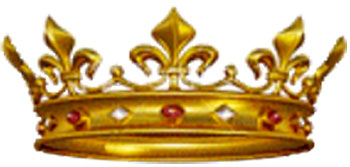
"The princedoms of Vere are ancient cultural manifestations of
genetic qualities carried in the historical Elven Blood Royal.
Established in Angiers in 740 A.D.
as a Royal House arising from far older sacral-regal, Pictish,
Scythian Vere origins rooted in antiquity, the House of Vere is
recorded in a single name and in an unbroken line for over one
thousand three hundred years, and consequently is one of the
oldest surviving royal dynasties in Europe."
Nicholas de Vere
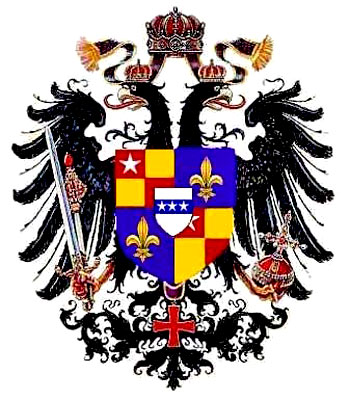
De Vere Family
Crest
Imperial status, authenticity and
legitimacy are based on
factual history, as well as the power of sacred history.
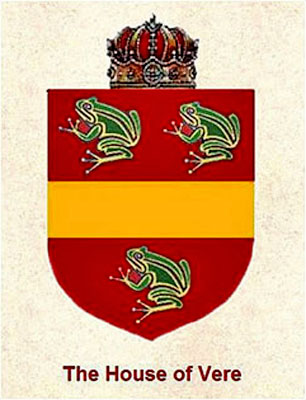
Another
Crest for the House of Vere
The House of Vere are descended in numerous lines from the
Merovingian dynasty and consequently share in this ancient Germanic
Royal Blood Tradition.
Prince Milo de Vere - married to
Charlemagne's sister - and as Head of the Imperial House and Chief
of the Imperial Army, was himself an Imperial Prince.
A True Royal house
The Royal House of Vere - The Senior Angevin House of the original
'Princes and Counts of Anjou' - are latterly of Breton and Flemish
extraction and the former senior, Scottish Branch.
Hope-Vere of Blackwood, traditionally
observed the Flemish law of Noblesse Uterine, and matrilinear and
family inheritance in accordance with noble Scottish family law,
which contemporarily and historically supports blood descent.
The Titles of Princeps Draconis and Prince de Vere, currently held
by Nicholas de Vere, are acknowledged as foreign titles in
confidential files held by the British Government's Department of
Internal Affairs:
'The Home Office' and are registered
with them as 'Official Observations'.
These titles are recognized by the most
senior branches of the House of Vere. The right of fons honorum held
by Nicholas de Vere is also acknowledged by Her Majesty's
government.
Nicholas de Vere, though accepting the existence of both with some
considerable qualification; does not claim to be either a member of
the contemporary British royal household or of its peerage in any
sense, and does not claim any status or rank suggestive of such or
appertaining thereunto. The Vere princedoms are not modern, socially
derived titles; either assumed or bestowed, for or by, political
expediency.
The princedoms of Vere are ancient cultural manifestations of
genetic qualities carried in the historical Elven Blood Royal.
Established in Angiers in 740 A.D. as a
Royal House arising from far older sacral-regal, Pictish, Scythian
Vere origins rooted in antiquity, the House of Vere is recorded in a
single name and in an unbroken line for over one thousand three
hundred years, and consequently is one of the oldest surviving royal
dynasties in Europe.
Sovereign
Dragon Court and Nation
Descended From Antiquity
"The princedoms of Vere are ancient
cultural manifestations of genetic qualities carried in the
historical Elven Blood Royal. Established in Angiers in 740 A.D.
as a Royal House arising from far older sacral-regal, Pictish,
Scythian Vere origins are rooted in antiquity.
The House of Vere is recorded in a
single name and in an unbroken line for over one thousand three
hundred years, and consequently is one of the oldest surviving
royal dynasties in Europe."
From: The Duchy of Angiers and
The Royal House of Vere
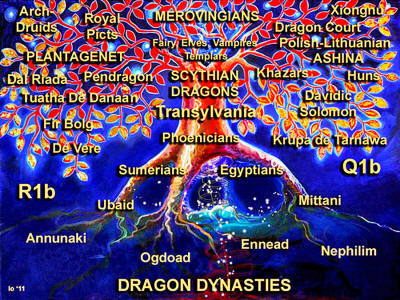
The Dragon
Blood Royal Dynasties
Paternal - Maternal Descent: The DNA Bridge
Paternal and Mitochondrial Dragon DNA explains the importance of the
female decent.
Mitochondrial DNA is passed only through
the female line. Mitochondria is a living sentient and separate life
form from ourselves. The mitochondria are dependent on us for life;
we live in a symbiotic relationship.
Mitochondrial DNA can live 15
generations. 15 generations of living mitochondria live inside you.
Your 15 generation grandparents living cells are in you. A mutant
mtDNA will drift to fixation in a human matrilineal in 15
generations. Recently an attempt was made to estimate the age of the
human race using mitochondrial DNA.
This material is inherited always from
mother to children only.
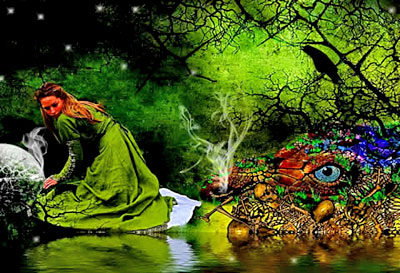
The Dragons'
Midwife
by Rusty Mermaid
"Although she specializes in the
hatching of Dragon eggs this Midwife knows that she has to
deliver a healthy baby Dragon... or she will end up in the pile
of bones. On the other hand she could leave with as much gold as
she can carry!"
Rusty Mermaid
By measuring the difference in
mitochondrial DNA among many individuals, the age of the common
maternal ancestor of humanity was estimated at about 200,000 years.
It remains implausible to explain the
known geographic distribution of mtDNA sequence variation by human
migration that occurred only in the last 6,500 years.
Mitochondrial DNA (mtDNA)
(by virtue of its maternal, non recombining mode of inheritance,
rapid pace of evolution, and extensive intraspecific polymorphism)
permits and even demands an extension of phylogenetic thinking to
the microevolutionary level. Many species exhibit a deep and
geographically structured mtDNA phylogenetic history.
Study of the relationship between
genealogy and geography constitutes a discipline that can be termed
intraspecific phylogeography, ’alien genes’ in human DNA.
The (Central Asian) Khazar name is
derived from Turkic *qaz-, meaning "to wander." The Ashina was
considered a sacred clan of quasi-divine status. Q1 actually refers
to the subclade Q-P36.2.
The
Ashina clan, a noble caste, carry
the 16q24.3 "red gene" inherited from the Sumerian Anunnaki, the
root of the Dragon seed that permeates royal lines:
-
Merovingian
-
Carolingian
-
Tudor
-
Plantagenet
-
Stuart
-
Hapsburg
-
Hanoverian
-
Saxe-Coburg-Gotha
-
Guelph
-
Bowes-Lyon
-
Battenberg (Mountbatten)
-
Guise
-
Savoy,
...families - and Transylvanian
lineages.
The Davidic House of Judah
married into the descent of the Merovingian Kings of the Franks.
They are connected by a shared bloodline. The dragon archetype rests
within the Dragon blood, passed on through the genes.
The re-expansion of paternal group R1b and maternal group H from the
Basque Ice Age refuge spread up the coasts of all the countries
facing the Atlantic, after the ice melted.
The British Isles retained higher rates
than the other countries, for several reasons related specifically
to early movements directly from the Basque country rather than from
general diffusion from western Europe.
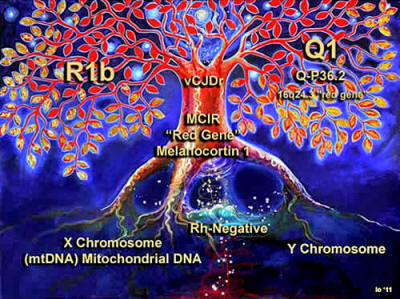
R1b and Q1
Blood Descent
First, as a result of lower sea levels, the British Isles, in
particular Ireland, were connected and at the furthest edge of the
extended Ice Age European continent, and thus received the bulk of
early coastal migration.
Then, as sea levels rose, first Ireland
then Britain became islands, relatively insulated from further
migration from elsewhere in Europe, thus preserving their high rates
of R1b and similarity to the initial settlements.
The means by which I could separate the
R1b types in the British Isles from those on the other side of the
channel is by the use of “Founder Analysis.”
That is, looking at the detail of their
gene types (so-called
STR haplotypes). These revealed 21
founding clusters, which could only have arrived direct from the
Basque country.
Their descendant twigs are unique
to the British Isles.
Founding of the Royal
Court
According to Nicholas de Vere:
"Briefly, the Dragon lineage starts
in the Caucasus with
the Anunnaki, descending
through migrating proto-Scythian to the Sumerians while
branching off also into the early Egyptians, Phoenicians and
Mittani.
A marriage bridge back to Scythia
infused the Elvin line of “Tuatha
de Danaan” and the Fir Bolg, which branched into the
Arch-Druidic, Priest-Princely family to the Royal Picts of
Scotland and the ring kings of the Horse Lords of Dal Riada,
through the Elven dynasty of Pendragon and Avallon del Acqs, and
down to a few pure bred families today."
Nicholas de Vere
The Royal Court of the Dragon was
founded by the priests of Mendes in about 2200 BC and was
subsequently ratified by the 12th dynasty Queen Sobeknefru.
This sovereign and priestly Order passed
from Egypt to the Kings of Jerusalem; to the Black Sea Princes of
Scythia (Princess Milouziana of the Scythians) and into the Balkans
- notably to the Royal House of Hungary, whose King Sigismund
reconstituted the Court just 600 years ago. Sigismund’s assumed
descent from Melusine.
Her ancestry actually can be traced back
to the Scythian Dragon Princess Scota, Queen Sobekh Nefru and the
Egyptian Cult of the Dragon. Vlad Dracul was a minion of
Sigismund of Luxembourg, and was educated at the Emperor's court in
Nuremberg. Dracul was invested into Societas Draconis.
The Byzantine Emperor Constantine was a Dragon King. The Byzantine
emperor Leo III married his son Constantine (V) to the Khazar
princess as part of the alliance between the two empires.
Princess Tzitzak was baptized as Irene.
Their son Leo (Leo IV) was known as "Leo the Khazar", emperor of the
Eastern Roman (Byzantine) Empire from 775 to 780.
RH Negative Blood Type
Where did the
Rh negatives come from? If they are
not the descendants of prehistoric man, could they be the
descendants of the ancient astronauts?
All animals and other living creatures known to man can breed with
any other of their species. Relative size and color makes no
difference.
Why does infant's haemolytic disease
occur in humans if all humans are the same species?
Haemolytic disease is the allergic
reaction that occurs when an Rh negative mother is carrying a Rh
positive child. Her blood builds up antibodies to destroy an ALIEN
substance (the same way it would a virus), thereby destroying the
infant. Why would a mother's body reject her own offspring?
Nowhere else in nature does this occur
naturally. This same problem does occur in mules - a cross between a
horse and donkey. This fact alone points to the distinct possibility
of a cross-breeding between two similar but genetically different
species.
No one knows where the Rh negative people came from.
Rhesus negative blood simply means that
the blood doesn't have any Rhesus antigens on the surface of the red
blood cells. An "absence" of a protein does not necessarily have to
originate from anywhere. The simplest explanation is that Rh
negative blood is caused by a mutation on the first chromosome which
rendered individuals incapable of producing functional Rhesus
proteins.
As for why there are so few people with
Rh negative blood, Rh-negative is a recessive trait, so all an
individual needs is one functional Rhesus gene to produce Rh
positive blood.
Since Rh negative blood does not hinder
an individual's survivability or confer any evolutionary
disadvantage other than the inability to receive Rh positive blood
(which is pretty much a non-factor during the time period when blood
transfusions weren't available), people with non-functional Rhesus
genes continued to thrive and reproduce which is why there are still
individuals with Rh negative blood.
Most, familiar with blood factors, admit that these people must at
least be a mutation if not descendants of a different ancestor.
If we are a mutation,
-
What caused the mutation?
-
Why does it continue with the
exact characteristics?
-
Why does it so violently reject
the Rh factor, if it was in their own ancestry?
-
Who was this ancestor?
Difficulties in determining ethnology
are largely overcome by the use of blood group data, for they are a
single gene characteristic and not affected by the environment.
The Basque people of Spain and France have the highest percentage of
Rh negative blood. About 30% have (rr) Rh negative and about 60%
carry one (r) negative gene. The average among most people is only
157%-Rh negative, while some groups have very little.
The Oriental Jews of Israel, also have a
high percent Rh negative, although most other Oriental people have
only about 1% Rh negative. The Samaritans and the Black Cochin Jew
also have a high percentage of Rh negative blood, although again the
Rh negative blood is rare among most black people.
The Rh-Negatives Factor is considered a "Mutation" of "Unknown
Origin", which happened in Europe, about 25,000-35,000 years ago.
Then this group spread heavily into the area of what is now Spain,
England, Ireland, etc. 5% of the Earth's population are currently Rh-Negatives.
But, they are 15% of the population of
the England and the USA. The most distinctive members of the
European branch of the human tree are the Basques of France and
Spain. They show unusual patterns for several genes, including the
highest rate of the Rh-negative blood type. Their language is of
unknown origin and cannot be placed within any standard
classification.
Consider Iceland, 1% of its population is Rh-negative.
The population of Iceland is about
two-third of Scandinavian and one-third of Irish descent.
Scandinavia, Ireland, and the British Isles show from 16% to 25% and
above Rh-negative. The other populations with a proportion of
Rh-negative individuals similar to Iceland occupy the eastern half
of Asia, Madagascar, Australia and New-Zealand.
The people of the Basque region have a
greater than 50 percent concentration of the RH negative gene. The
frequency decreases in relation to the distance from the Basque
region into the rest of the world until there is very little
evidence of this gene.
This genetic mapping helps to show that a mutation from RH positive
to RH negative occurred somewhere in the Basque area of Europe maybe
as much as 40,000 years ago.
Science tells us that the red hair DNA
did not originate with human beings but was Neanderthal DNA.
"When we look at the Y-chromosomes
in Wales and Ireland, we find a very close match with the
Basques."
"Other genetic evidence, he says,
strongly suggests that the Basques are the descendants of the
Paleolithic inhabitants of Western Europe prior to the arrival
of farmers between 9,000 and 6,000 years ago".
During a period in history known as the
Dark Ages, which happened around 1200 - 800 B.C. The "Tribe of Dan"
was shipped into Western Europe with the aid of the Phoenicians from
the Mediterranean Sea at about the same time in history. They came
into Spain, France (Languedoc Area of France).
We also know that the 10 Lost Tribes of Israel known as the Hebrews
migrated into Europe and became a blended group who would later
become known as the Scythian, aka Aryan Races.
They migrated into Europe from the
Caucasus and Carpathian mountain ranges while the Tribe of Dan into
Spain, France and the British Isles from the Mediterranean Sea.
Phoenicians helped transport the Tribe
of Dan into Spain, France, and the British Isles by way of the "Sea
Route," from the Middle East. Phoenicians appear to be the Siberians
of Russia, the Yakuts, Sakha and the Buryats.
THEY ARE THE SAME RACE WITH THE SAME
DNA.
They have the same spiritual and
historical traditions: the same names of landforms, rivers.

No one really knows
where the Rh negative people came from?
Rh-negative women and men have several "Unusual Traits" that
Rh-positives don't:
-
An EXTRA-Vertebra (a "Tail
Bone"): some are born with a tail (called a "Cauda").
CAUDA EQUINA - The bundle of spinal nerve roots arising from the
end of the spinal cord and filling the lower part of the
spinal canal (from approximately the thoracolumbar junction
down).
-
Embryology: Caudally the tail
region projects over the
cloacal membrane.
-
Lower than normal Body
Temperature.
-
Lower than normal Blood
Pressure.
-
Higher mental analytical
abilities.
-
Higher Negative-ion shielding
(from positive "charged" virus/bacteria) around the body.
-
High Sensitivity to EM and ELF
Fields.
-
Hyper Vision and other senses.
Another salient genetic feature is the the shape and sutures
(bone joints) of cranial bones of Basques (The skull ridge).
-
Tendency to having a thicker
breast bone (sternum).
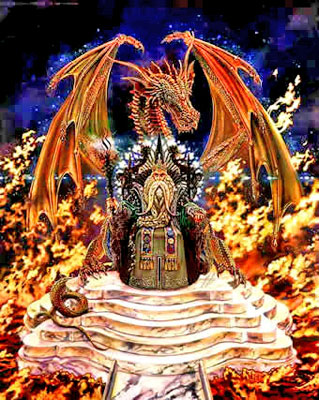
Dragon King
The
Merovingian Dragons and Divine Kingship
“The all-important element of the
Divine Right is that it comes from God, or ‘the gods’,
alternately. And who were these gods?
Authors such as
Zecharia Sitchin, Sir
Laurence Gardner and
Nicholas de Vere are
authoritatively convinced that kingship was created by an
advanced race of beings called the Anunnaki, also called
the Nephilim in the Old
Testament.
These were the ones who created the
human race and interbred with a portion of it to create the
kingly caste which until this day has still maintained control
over the Earth.
These celestial creatures have been
variously identified with Dragons, Elves, Fairies, Gnomes,
Leprechauns, Sprites, Nymphs, Pixies, Angels, Demons, Devils,
Witches, Giants, Vampires, Werewolves, and just about every
mythical being you can imagine.
Some, like Gardner and Sitchin,
claim that they come from another planet. Others, like de Vere,
say that they're multi-dimensional, or that they’re from the
Hollow Earth.”
“The
Biological Basis of Elitism and Divine Right Rule”
Early Sumeria and the Origins of
Kingship
One of the interesting items from the archives of the Dragon Court
was the origin of the word 'kingship'. It derives from the
very earliest of Sumerian culture
wherein 'kingship' was identical with 'kinship' - and 'kin' means
'blood relative'.
In its original form, 'kinship' was 'Kainship'.
And the first King of the Messianic
Dragon succession was the biblical 'C(Kain)', head of the Sumerian
House of Kish.
"On recognizing this, one can
immediately see the first anomaly in the tradition of the
Genesis story, for the historical line from David to Jesus
was not from Adam and Eve's son, Seth, at all.
It was from Eve's son Cain, whose
recorded successors (although given little space in the Old
Testament) were the first great Kings (or Kains) of Mesopotamia
and Egypt.
According to the Dragon tradition, the importance of Cain was
that he was directly produced by Enki [Satan] and Ava [Eve], so
his blood was three quarters Anunnaki. His half brothers Hevel
and Satanael (better known as Abel and Seth) were less than half
Anunnaki, being the offspring of Ateba and Ava (Adam and Eve).
We can now progress our story by considering the oldest Grant of
Arms in sovereign history - the Grant of Arms which denoted the
Messianic Dragon Bloodline for all time. The Sumerians referred
to this insignia as the Gra-al... From biblical history, we know
it better as the 'Mark of Cain'."
Laurence Gardner
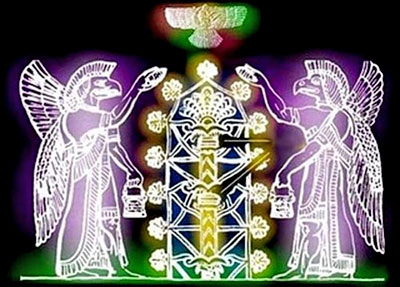
Dragon
Anunnaki Nurturing the Tree of Life
Sumerian and Babylonian King-Lists reveal the belief that “kingship”
was “sent down” from “heaven” - decreed by the gods.
Many indigenous antic cultures followed
the same tradition, including the Xiongnu, Scythians and Saka.
Dynastic lists of pre-diluvial Sumerian kings were later
re-catalogued in Babylon by Priest-Scribes.
The Egyptians also produced and
monumentalized King-Lists, documenting the lineage of the Houses of
their God-Kings in stone for all of Eternity. A name remembered was
an afterlife assured.
The Dragon King was known as the King of Kings and his symbol,
Draco, represented his succession through the Egyptian pharaohs, the
Egyptian Therapeutae, the Qumran Essenes to the Merovingian kings of
Europe.
"The kings of the early succession
(who reigned in Sumer and Egypt before becoming kings of Israel)
were anointed upon coronation with the fat of the Dragon (the
sacred crocodile).
This noble beast was referred to in
Egypt as the Messeh (from which derived the Hebrew verb 'to
anoint'), and the kings of this dynastic succession were always
referred to as 'Dragons', or 'Messiahs' (meaning 'Anointed
Ones').
In times of battle, when the armies of different kingdoms were
conjoined, an overall leader was chosen and he was called the
'Great Dragon' (the 'King of Kings') - or, as we better know the
name in its old Celtic form, the 'Pendragon'.
In pictorial representation, the Messianic Dragon was, in
essence, a large-jawed serpent with four legs, very much like a
crocodile or a monitor. This was the Sacred Messeh whose name
was 'Draco.'
Draco was a divine emblem of the
Egyptian pharaohs, a symbol of the Egyptian Therapeutate, of the
Essenes of Qumran, and was the Bistea Neptunis (the sea serpent)
of the descendant Merovingian Fisher-Kings in Europe."
Laurence Gardner
“Through the work of Sir Laurence Gardener we discover that
Sumaire in the old Irish language means Dragon.
He writes:
‘It is also reckoned that the
subsequent culture of the region, phonetically called
Sumerian (pronounced ‘Shumerian’) was actually Sidhemurian (Shee-murian).
This case is now considerable since the early Ring Lords of
Scythia , the Tuatha De Danaan king tribe were actually
called the ‘Sumaire’.'
During the days of the Biblical
Great Exodus, a group separated from Moses and went to the
North. This group was the Tribe of Dann.
Millions went and settled in the European and Scandinavian
areas. From there they spread out to other parts of the world,
conquering the countries, spreading their Anunnaki seed and
replacing the conquered people’s traditions with their own
serpent culture.”
The Tribe of Dann and the Lost
Tribe of Israel
The Canaanite territory of northern
Israel was later occupied by the tribe of Dan, whose worship of
Baal/Pan involved such fertility rites at Mount Hermon, also called
Mount Sion.
Merovingians are the offspring of
the tribe of Dan which intermarried with the Canaanite
Tuatha De Danann, also known as the
Dragon Lords of Anu because they were said to be the offspring of
the fallen angels (Anunnaki).
When God dispersed the northern tribes
for their wickedness, the tribe of Dan migrated to Greece, and later
to France and the British Isles where they established pagan
priesthoods and royal dynasties of the demonic bloodline:
“The Tuatha De Danann (or Dragon
Lords of Anu)... [before settling in Ireland (from about 800
B.C.)]... were the... Black Sea princes of Scythia (now Ukrane).
Like the original dynastic Pharaohs,
they traced their descent from the great Pendragons of
Mesopotamia; from them sprang the kingly lines of the Irish
Bruithnigh and the Picts of Scotland’s Caledonia. In Wales they
founded the Royal House of Gwynedd, while in Cornwall in the
southwest of England, they were the sacred gentry known as
Pict-Sidhe.
So, from a single caste of the original Blood Royal - whether
known as the Sangréal, the Albi-gens or the Ring Lords - we
discover many of the descriptive terms which sit at the very
heart of popular folklore.
For here, in this one noble race, we
have the ‘elves’, ‘fairies’ and ‘pixies’ - not beguiling little
folk, but distinguished Kings and Queens of the Dragon
succession.”
Laurence Gardner,
In the Realm of
the Ring Lords
In ‘The Psalter of Cashel’ it states
that:
‘The Tuatha de Danaan’ ruled in
Ireland for about two centuries, and were highly skilled in
architecture and other arts from their long residence in
Greece.’ The Tuatha de Danaan were the descendants of Danaus,
the son of Belus, who went with his fifty daughters to Argos,
the home of his ancestors Io.
In Irish legends the Tuatha de
Danaan, who were considered to be demigods,... were said to have
possessed a... Grail-like vessel... These teachers of wisdom...
were the founders of the Druidic priesthood.”
Van Buren, The Sign of the Dove
In Europe and the British Isles, the
Dragon lineage intermarried with the royal families and became
sovereigns.
The Pendragons
The Druidic Dragon King or Pendragon, also called the King of Kings,
was chosen by a Council of Elders to rule over all the kingdoms.
"Cymbeline was the 'Pendragon' of
mainland Britain during Jesus's lifetime. The Pendragon, or
'Head Dragon of the Island'... was the King-of-Kings and
'Guardian of the Celtic Isle'.
The title was not dynastic;
Pendragons were appointed from Celtic royal stock by a Druidic
council of elders.
The concept of the dragon in Celtic mythology emerged directly
from the holy crocodile (the Messeh) of the ancient Egyptians.
The Pharaohs were anointed with crocodile fat, and thereby
attained the fortitude of the Messeh (Thus Messiah - Anointed
One). The image of the intrepid Messeh evolved to become the
Dragon, which in turn became emblematic of mighty kingship.
The Celtic Kings in Britain were called 'dragons' in the ancient
Messeh tradition as intrepid guardians. But there were many
separate kingdoms in those days before England gained an overall
monarch in Saxon times. It was therefore necessary to appoint a
King-of-Kings - a High King to preside overall, and to lead
combined armies from different tribal areas.
The first Pendragon (Head
Dragon/High King) was Cymbeline.
Columba... in 574, had crowned and anointed King Aedan mac
Gabran of Dalriada (Celtic Pendragon and father of King Arthur)
- the first British monarch to be installed by priestly
ordination - and this greatly upset the Church of Rome."
Laurence Gardner
The Merovingians
The Druidic Pendragon was passed on to the Merovingian kings in 666
A.D.:
"The Celtic Pendragons were not
father-to-son successors in a particular descent, but were
chosen from various reigning dragon families and individually
elected by a druidic council of elders to be the King of Kings.
The last Pendragon was Cadwaladr of
Gwynedd, who died in A.D. 664. At around that time much of
Britain fell to the Germanic influence of the invading
Anglo-Saxon and Angle-land (England) was born as distinct from
Scotland and Wales."
Laurence Gardner
"In 666, probably still in Ireland, Dagobert married Mathilde, a
Celtic princess."
Baigent, Michael, Richard Leigh
and Henry Lincoln,
Holy Blood, Holy Grail.
"The Merovingian kings were noted sorcerers in the manner of the
Samaritan Magi"
Laurence Gardner,
Bloodline of
the Holy Grail
The term “Merovingian” is said to derive
from Merovee, King of the Franks from 447-458 A.D.
According to the legend, as explained in
Bloodline of the Holy Grail, Merovee had two fathers, King Clodion
and a strange “beast of the sea.”
“Despite the carefully listed
genealogies of his time, the heritage of Meroveus was strangely
obscured in the monastic annals. Although the rightful son of
Clodion, he was nonetheless said by the historian Priscus to
have been sired by an arcane sea creature, the Bistea Neptunis.
The Sicambrian Franks, from whose
female line the Merovingians emerged were associated with
Grecian Arcadia before migrating to the Rhineland. As we have
seen, they called themselves the Newmage - ‘People of the New
Covenant’, just as the Essenes of Qumran had once been known.
It was the Arcadian legacy that was
responsible for the mysterious sea beast - the Bistea Neptunis -
as symbolically defined in the Merovingian ancestry. The
relevant sea-lord was King Pallas, a god of old Arcadia...
The immortal sea-lord was said to be
‘'ever-incarnate in a dynasty of ancient kings’ whose symbol was
a fish - as was the traditional symbol of Jesus.”
Laurence Gardner, Bloodline of
the Holy Grail
The legend of King Merovee conceals the
TRUE origins of the Merovingian race in remote antiquity. “Meroveus”
derives from the French words “mer” meaning “sea” and “Vere” meaning
“werewolf” or “dragon.”
The book of Revelation informs us that
the dragon is “the Devil, and Satan,” hence the esoteric allusion to
the Merovingians’ progenitor, King Merovee, a king of France sired
by a mysterious “beast of the sea,” is a claim that the Merovingian
dynasty has literal Satanic descent:
"There was a very great 'Jewish'
component among the Sicambrian Franks/Merovingians and, because
they practiced polygamy (another Merovingian peculiarity) they
left a great number of offspring.
These aristocratic Merovingian
children married into almost all of the noble families of Europe
during the 5th, 6th, and 7th centuries. This has prompted more
than one historian to suggest that the foundation of European
nobility is Jewish!"
Michael Bradley, Holy Grail
Across the Atlantic
"There are at least a dozen families in Britain and Europe today
- with numerous collateral branches - who are of Merovingian
lineage. These include the House of Hapsburg-Lorraine...
Plantar, Luxembourg, Monetized, Montes que, and various others.
According to the 'Prewar documents'
the Sinclair family in Britain is also allied to the bloodline,
as are various branches of the Stu arts... In many of its
documents the Sion asserts that the new king, in accordance with
Merovingian tradition, would 'rule but not govern'.
In other words he would be a
priest-king who functions primarily in a ritual and symbolic
capacity; and the actual business of governing would be handled
by someone else - conceivably by the Priori de Sion."
Baigent, Michael, Richard Leigh
and Henry Lincoln, Holy Blood, Holy Grail
After the Merovingian dynasty was
deposed by the Roman Church in 800 AD, their demonic bloodline was
preserved by the “Imperial and Royal Dragon Court” which conspired
to regain control of the Holy Roman Empire through infiltration of
Church and State.
Their insignia was the dragon in the form of a
circle and a red cross - the Rosy Cross of
the Priori de Sion, the
Knights Templar and the Rosicrucians.
“When the Imperial and Royal Dragon
Court was reconstituted by King Sigismund in 1408 as the
Societas Draconis, it was based upon an ancient bloodline
tradition which Sigismund assumed that he had inherited from his
presumed Egyptian and Scythian ancestors through the Pictish,
Dragon Princess Maelasanu of Northumbria and the Ancient and
Original Angevin Royal House of Vere of Anjou, the Imperial
Dukes of Angiers.
This line had descended through the
Tuatha de Danaan (the Dragon Kings of Anu) on the one hand, and
the Egyptian Dragon Dynasty of Sobek on the other. The latter
strain included the bloodline of the Davidic House of Judah who
married into the descent of the Merovingian Kings of the Franks.
In 1408 (when Britain was in her Plantagenet era), the Dragon
Court was formally reconstituted as a sovereign body at a time
of wars and general political turmoil...
The founding document... stated that
members of the Court might wear the insignia of a dragon in
curved into a circle, with a red cross - the very emblem of the
original Rosicrosse which had identified the Grail succession
from before 3000 B.C.”
Laurence Gardner, Genesis of the
Grail Kings
The Merovingian dynasty still maintains
its legitimacy and will one day openly assert
the divine right of their nobility to rule the
world as an angelic race of demigods, whose ancestors
were the fallen angels.
King of Scots
Robert the Bruce was far more than an "early Scottish King."
He was a high born
Merovingian:
-
Priest-King of the Celtic Church
-
Liberator of Scotland from
England
-
Sovereign Grand Master of the
Order of the Knights Templar
-
Founder of the Order of the Rosy
Cross
"In 1307... under the auspices of Robert the Bruce and the
excommunicated clergy, the Order was restructured into a Church,
with a hierarchy quite independent of Rome. The Templar Church
had abbots, priests, and even bishops...
The Knights began to train the army
of Robert the Bruce in the hit-and-run tactics of warfare
established in the Crusades...
The Roman Church may have
betrayed the Templars, but in Scotland they found something far
more trustworthy and tangible: a sacred royal house and a
Priest-King of the Celtic Church succession.
The King of Scots was installed as the hereditary Sovereign
Grand Master, and from that time, whichever descending King held
that office, he was to be known as 'Saint Germain.'
A new Order was then formed, called
the Elder Brothers of the Rosy Cross, and several of the Rosy
Cross Knights then sailed to France for a meeting with Pope John
XXII at Avignon.
Many historians have presumed therefore that the Knights
Templars must have disbanded in Scotland, but this was not the
case; it was simply that Bruce had contrived the secret Order to
become even more secretive.
Indeed, the Order of the Knights of
the Rosy Cross had been established by Bruce for Templars who
had been valiant at Bannockburn, and this was a very successful
cover."
Prince Michael Stewart,
The
Forgotten Monarchy of Scotland
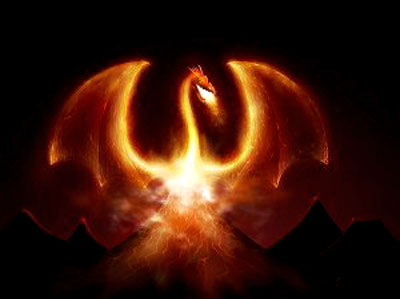
|















